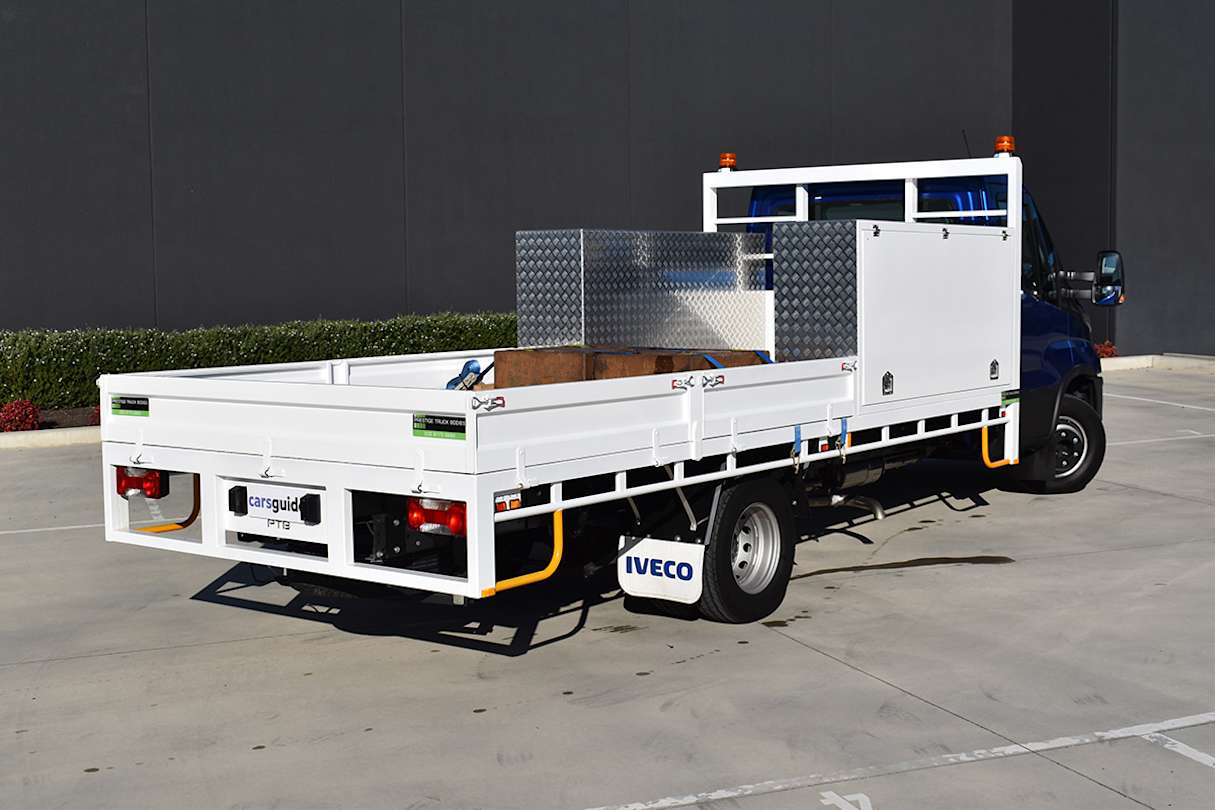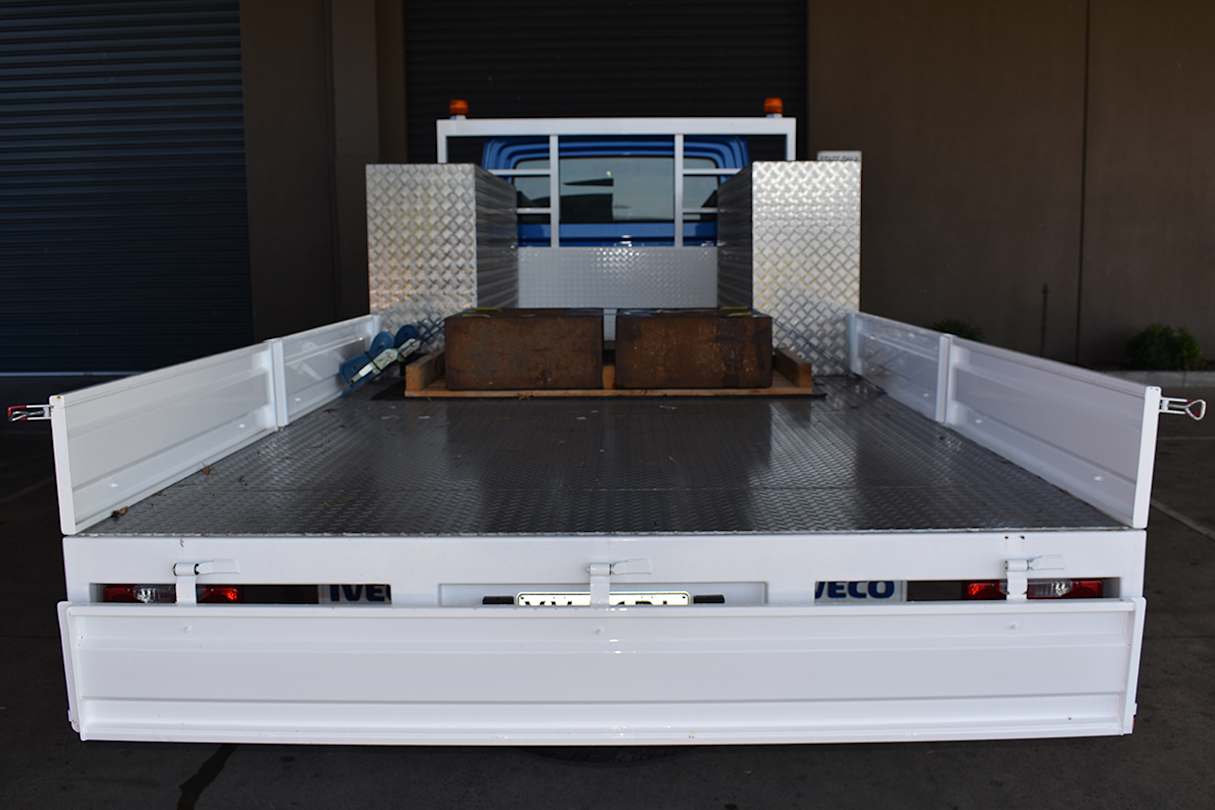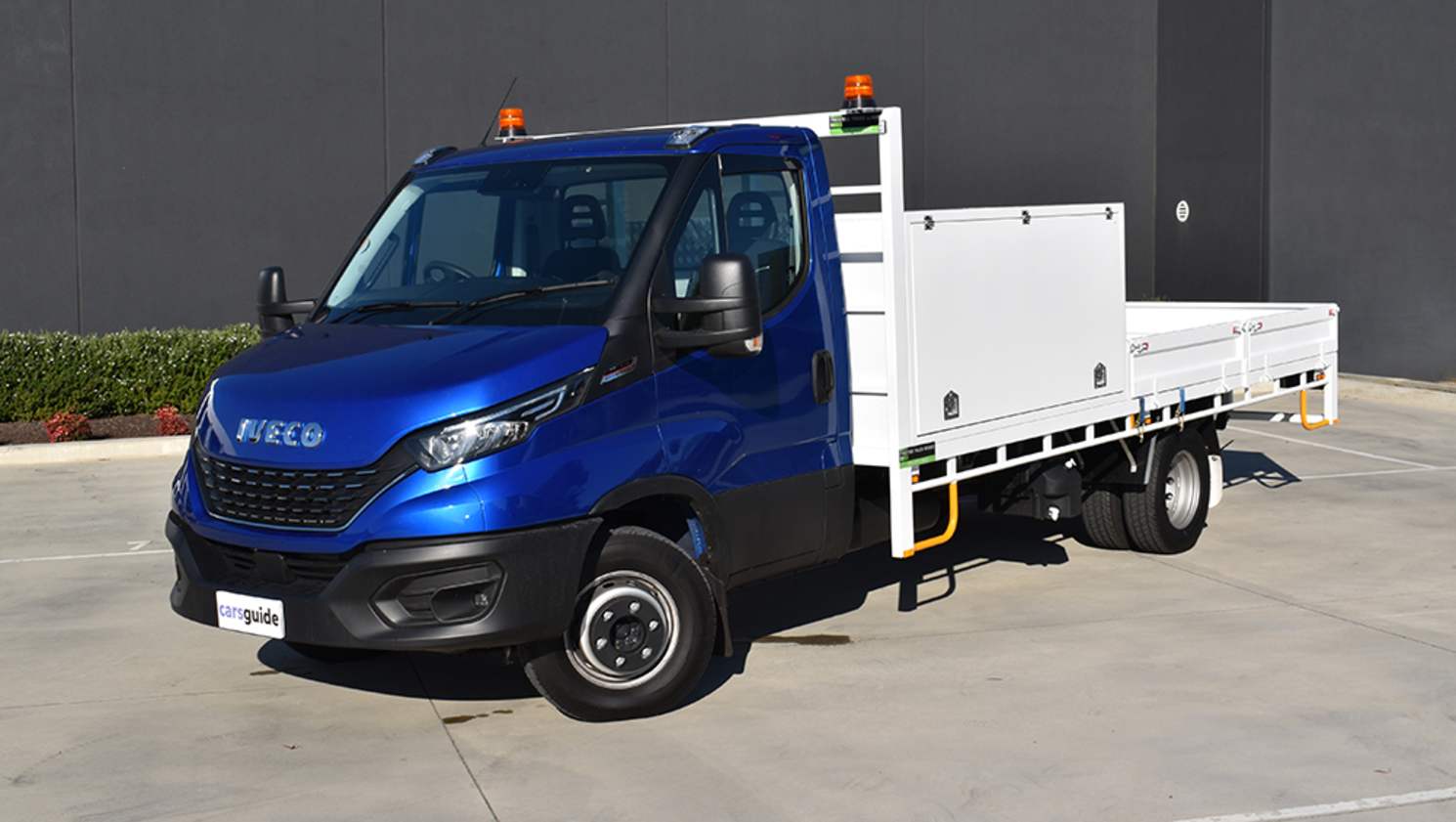The MY21 Iveco Daily E6 cab-chassis range competes in the Light Duty (3501-8000kg GVM) segment of Australia’s Heavy Commercial vehicle market, where competition is fierce with a dozen brands and 15 models battling for buyers.
The E6 cab-chassis, like its closely-related van sibling recently tested by CarsGuide, brings the latest Euro 6-compliant engines, improved active safety including adaptive cruise control and AEB plus enhanced cabin styling and appointments.
It’s available in a choice of two model grades and single-cab or dual-cab bodies and buyers are spoilt for choice in terms of different configurations to suit a wide variety of jobs. We recently spent a week in a premium 7200kg GVM model that required a truck licence to drive it.
Iveco Daily 2022: 70S18H 4X4 Srw (Wb3480) 4.495T
| Engine Type | Diesel Turbo 4, 3.0L |
|---|---|
| Fuel Type | Diesel |
| Fuel Efficiency | 0.0L/100km (combined) |
| Seating | 3 |
Price and Features – Does it represent good value for the price? What features does it come with?
Our test vehicle is the Daily E6 70C single cab-chassis which has the highest load ratings of the two models offered. It’s armed with the top-of-the-range 210EVID 3.0-litre four-cylinder turbo-diesel and ZF Hi-Matic eight-speed torque converter automatic options, for a list price of $80,707. It’s also equipped with an optional single passenger seat, which like the driver’s seat is suspended, heated and fully adjustable, at extra cost.

Standard equipment includes an intelligent electronic parking brake, electric windows, heated exterior mirrors with electric adjustment and indicators, height-adjustable flat-bottom steering wheel, cordless mobile phone charging, daytime running lights, keyless entry/central locking and a new driver’s hi-res colour instrument cluster with seven dedicated screen menus providing more than 100 points of vehicle information to name a few.
Its six 16-inch steel wheels (dual rears) are fitted with 225/75 R16 tyres and there’s a full-size spare carried under the rear of the chassis frame. There’s also a large choice of individual options, plus four equipment upgrade packs which allow buyers to benefit from the ‘bulk-buy’ value of grouping options.
Design – is there anything interesting about its design?
The rear wheel-drive E6 70C cab-chassis range offers six different wheelbases from 3450mm to 5100mm. Our test vehicle’s 4350mm dimension falls somewhere in the middle, with an overall length of 7413mm (without tray). It rides on torsion bar front suspension with a leaf spring live rear axle and four-wheel disc brakes. Optional air-bag suspension and locking differential are available.
Our test vehicle is also fitted with a Prestige Truck Bodies steel tray-body, which combines two enormous toolboxes with a large open tray area that could be well suited to a variety of applications, particularly municipal councils and utilities companies. However, the 15.5 metre wall-to-wall turning circle would no doubt increase due to the rotating swing of this custom body’s longer rear overhang.
The base of the cabin body up to wheel-arch height, where most bumps and scrapes tend to be inflicted, is protected by tough black plastic panelling. It’s easy to climb aboard thanks to wide door openings and large grab handles on each windscreen pillar, with ample room between the flat-bottom steering wheel and driver’s seat for spacious access and operation.

The driver’s seat (and our optional single passenger seat) has a fold-down inboard armrest to reduce neck and shoulder strain. It also provides a cushioned ride that’s independent of the vehicle’s chassis movements, thanks to its own suspension system which can be adjusted to match a driver’s weight to ensure optimum comfort. The only thing missing is a proper driver’s left footrest.
There’s a large window in the cab's rear bulkhead which, for some tray-equipped models at least, offers a clear view behind, while large door mirrors with lower wide-angle lenses provide excellent views down each side. Overall, it’s a well-equipped and unusually stylish cabin environment, with controls that are well laid-out and easy to use.
Engine and transmission – What are the key stats for the engine and transmission?
The optional 210EVID 3.0-litre four-cylinder turbo-diesel, with direct injection and electronically controlled variable geometry turbocharging, produces 155kW at 3500rpm and a tractor-like 470Nm of torque at a low 1500rpm. Using AdBlue, it also meets the world’s toughest Euro 6 emissions standard. ZF’s 8V470A Hi-Matic eight-speed torque converter automatic has overdrive on the two top ratios to optimise fuel economy at highway speeds, plus a choice of three driving modes.

Fuel consumption – How much fuel does it consume?
Our test vehicle was lugging just under 2.0 tonnes of steel blocks for the duration of our test which when combined with the 1.5-tonne weight of its steel tray-body was sure to produce a higher combined consumption than our E6 van test vehicle achieved (11.7L/100km) with this drivetrain.
As expected, our cab-chassis returned 16L/100km after a week of city and suburban driving which would no doubt be less without a payload. Even so, our figures calculated from tripmeter and fuel bowser readings suggest you could expect a loaded driving range from its 100-litre tank of around 620km.
Practicality – How practical is the space inside?
Our test vehicle’s 2489kg tare weight, when deducted from its 7200kg GVM, equals a big 4711kg payload rating. It’s also rated to tow up to 3500kg of braked trailer and with its 10,500kg GCM it can haul its maximum payload while towing up to 3300kg of braked trailer, which is a handy set of numbers. Iveco also offers a lower 4495kg GVM option, for those without a truck licence.
There’s plenty of cabin storage options too, starting with large and small-bottle holders and three tiers of storage in each front door plus a full-width map shelf overhead. The dashboard also makes good use of space with small-bottle/cup holders on each side, a large open storage shelf above a single glovebox, another small glovebox-like compartment at the base of the central dash and three storage compartments across the top, with two USB ports and an audio jack in the central compartment and clamshell-type lids on the two outer ones.

What’s it like as a daily driver?
It was useful to lug a sizeable payload for the duration of our test, as such a work-focused vehicle would most likely do the same during its working life. As a result, we can’t comment on its (arguably irrelevant) unladen ride quality, but with the combined weight of the steel tray and added ballast over the rear wheels it was commendably smooth for a vehicle with a 7200kg GVM rating.
The engine’s 470Nm of torque, which is served full strength at 1500rpm, made light work of lugging this weight around. It offered ample pulling power either side of that peak value, which showcased good flexibility in what was mostly city and suburban driving. It also cruised economically at highway speeds with only 2000rpm required to maintain 110km/h.

There’s surprisingly brisk acceleration when maximum power is sed at 3500rpm and the eight-speed automatic is a delight to use, requiring single prods of the stumpy dash-mounted shifter to select either Eco-mode automatic, Power-mode automatic or sequential manual-shifting as required.
As an aside, the E6 cab-chassis is noticeable quieter than the van version, given the absence of tyre roar emanating from the rear wheel arches being amplified by a huge unlined cargo bay directly behind you.
The floating-on-air feel of the suspended driver’s seat, combined with nicely weighted power steering and a car-like dashboard lay-out, adds some credence to Iveco’s claim that the latest Daily range is more like a car to drive. Overall, it would be pretty easy to live with if you had to drive it every day.
What’s it like for tradie use?
The closest we could get to the Iveco’s 4711kg payload rating was 3420kg, which was the combined weight of the work-tray and two weight blocks loaded by Iveco. That was still more than 1200kg short of its payload limit but enough to give us some idea of its load-carrying capabilities.
It easily coped with this weight in most driving conditions and was particularly competent on hills, which we tackled in Eco-auto, Power-auto and sequential-manual modes. On steeper climbs we found Power-auto more than capable as it accesses the engine’s maximum torque and power, but being able to quickly shift into sequential-manual mode was really handy too, particularly on long descents when the ability to hold a lower gear to assist with engine-braking was much appreciated.

Warranty & Safety Rating
Safety – What safety equipment is fitted? What safety rating?
Although there are no ANCAP ratings in this vehicle segment, standard safety equipment includes four airbags, AEB, crosswind assist, adaptive cruise control and a suite of enhanced active safety features under Iveco’s ESP9 protocols. Additional active safety features are available as part of the Hi-Technology option pack.
Ownership – What does it cost to own? What warranty is offered?
The Iveco Daily is covered by a three years/200,000km/2500 hours warranty, whichever occurs first. Extended warranties available at extra cost up to five years/300,000km/6000 hours. Owners can also choose from a wide range of service plans.
Verdict
The competent performance and flexibility of its drivetrain, combined with good driver and cabin comfort, makes the latest E6 70C single cab-chassis a quality competitor in its weight division. With a long menu of engines, transmissions, wheelbases, chassis lengths, GVM/GCM ratings and factory options, a prospective owner should be able to choose a combination tailored to their specific requirements.
Pricing Guides









.jpg)
.jpg)
.jpg)
.jpg)
.jpg)

.jpg)